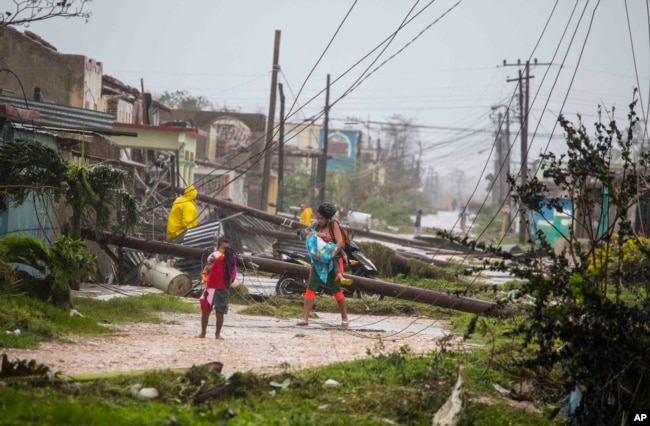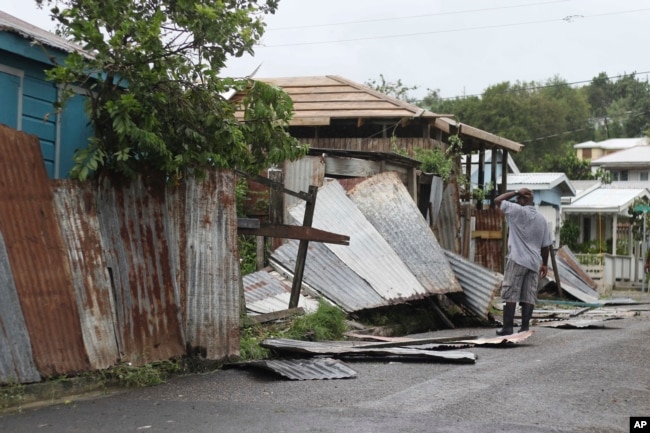
The northern eyewall of Hurricane Irma has come ashore at Key West, Florida after strengthening as it moved across the warm waters of the Straits of Florida.
Now a category 4 storm, Irma’s nearly 210 kilometer per hour winds and associated storm surge are expected to bring devastation to parts of the state that have not seen a major hurricane in a century.
Irma is expected to make landfall during the early morning hours of Sunday, first crossing the Florida Keys before tracking up the western coast of the state.
The storm’s track has shifted more to the west, now bringing the west coast city of St. Petersburg into its sights, despite earlier predictions that Miami, on Florida’s east coast, would bear the brunt of the storm.
Florida Governor Rick Scott told Floridians Saturday evening, “We are under a state of emergency,” urging them to leave evacuation zones.
“This is your last chance to make a good decision,” he added.
Scott also repeated his call for nurses and emergency workers to volunteer their help in the aftermath of the storm.
More than 75,000 people have heeded the governor’s advice and checked into some 400 emergency shelters in the state. Some 76,000 households are already reported to be without power. Since the storm changed course and headed west, residents of the mid-sized city of Tampa have been the latest wave of residents to surge into shelters after days of thinking they would only see the edges of the storm.
Tampa has not been directly hit by a hurricane in nearly a century.
Trump: ‘Get out of its way’
U.S. President Donald Trump and his Cabinet met Saturday at the presidential retreat in Camp David, Maryland, to discuss the hurricane.
“I think now with what’s happened with the hurricane, I’m going to ask for a speedup. I wanted a speedup anyway, but now we need it even more so,” he told Cabinet members. The White House released a video of his remarks.
He also called Irma a “storm of enormous destructive power” and asked “everyone in the storm path to heed all instructions, get out of its way.”
Irma was a Category 5 when it first hit the island of Cuba late Friday and battered it overnight. Cuba suffered damage similar to that of other Caribbean islands, with trees uprooted and roofs torn off homes. Power and cellphone service were spotty in many regions.
The Florida Keys are the first bit of U.S. soil to feel the effects of the storm. The slender barrier islands — with their population of retirees, vacationers and refugees from mainland culture — are under mandatory evacuation orders.
For those who resist the order and plan to ride out the storm on the Keys, “you’re on your own,” Federal Emergency Management Agency head Brock Long said Saturday.
“There is no safe area within the Keys,” Long said. “You put your life in your own hands by not evacuating.”
He added, “We are not going to be there right after the storm passes. We need to make sure roadways are clear, we need to get trucks in to get stuff there.”
Curfews for Florida
Further inland, some areas are under curfew late Saturday and early Sunday as residents await Irma’s onset.
In Homestead, Florida, south of Miami, people have been threatened with arrest if they are out after hours without a “valid, emergency purpose,” Zachary Good, spokesman for the city, said.
In Miami-Dade County, officials said more people have checked into hurricane shelters than at any other time in the county’s history. About 29,000 people were reported to have checked into county-run shelters, along with about 1,000 pets.
But space remains for last-minute decisionmakers: as of Saturday afternoon local time, only 16 of 42 shelters were reported full.
Governor Scott has asked residents who plan to stay home to have three days’ worth of supplies on hand to sustain themselves until emergency help arrives.
In all, Florida has asked 5.6 million people — more than one-quarter of the state’s population — to evacuate their homes ahead of the storm. Governor Scott has told all Floridians to be prepared in case they need to leave.
Destruction in the Caribbean
At least 25 people have died since the storm began raking its arms over land, starting with the Caribbean island of Barbuda.
The resort island with a population of less than 2,000 is devastated. Prime Minister Gaston Browne has estimated about 95 percent of Barbuda’s buildings are damaged or destroyed.
Until late Saturday, the island nation was braced for another direct impact, this one from Category 4 Hurricane Jose. By Saturday evening, Jose had skirted the island without imposing a direct hit.
It could be up to six months before all power is restored on cash-strapped Puerto Rico, a U.S. commonwealth, where Irma knocked out power to more than one million people.
The U.S. Defense Department has deployed three Navy ships, about two dozen aircraft and hundreds of Marines to help with recovery efforts in Puerto Rico and the U.S. Virgin Islands. | voanews





